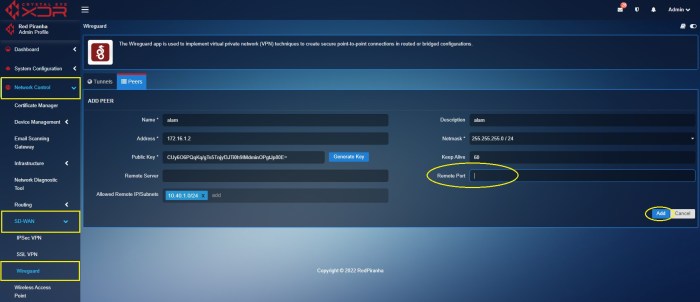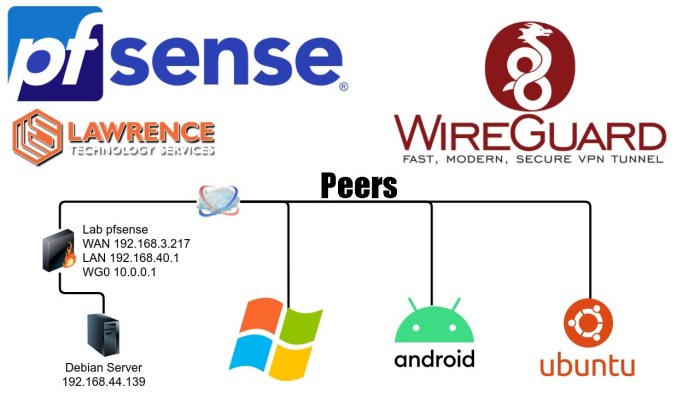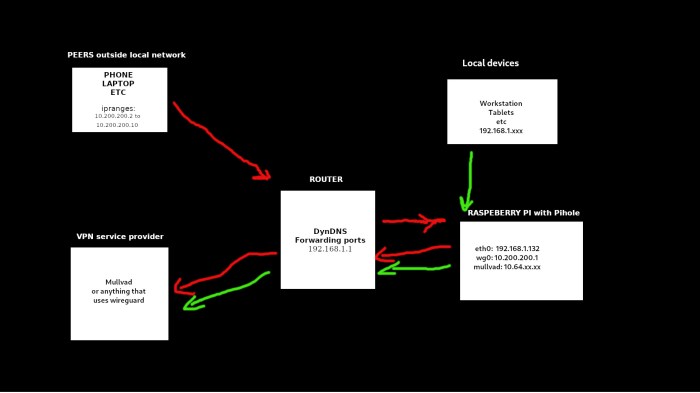In the realm of virtual private networks (VPNs), WireGuard has emerged as a game-changer, offering exceptional speed, security, and versatility. One of its most powerful features is split-tunneling, a technique that allows you to selectively route traffic through the VPN while maintaining direct access to local resources.
This article delves into the intricacies of WireGuard split-tunneling, providing a comprehensive guide to its benefits, configuration, security, performance, use cases, and troubleshooting.
Whether you’re a privacy-conscious individual, a network administrator, or simply seeking to enhance your online security, this guide will equip you with the knowledge and insights to harness the full potential of WireGuard split-tunneling. Discover how this innovative technology can revolutionize your networking experience, ensuring both privacy and flexibility without compromising performance.
Overview of WireGuard Split Tunnel
WireGuard is a modern VPN protocol that offers a unique feature called split tunneling. This feature allows you to route specific traffic through the VPN tunnel while excluding other traffic, providing greater flexibility and control over your network connections.
Split tunneling can be beneficial for several reasons. First, it can improve performance by reducing the amount of traffic that is encrypted and routed through the VPN. This can be especially helpful for applications that require low latency, such as gaming or video conferencing.
Second, split tunneling can enhance security by allowing you to isolate sensitive traffic from the rest of your network. For example, you could route all of your banking or financial transactions through the VPN while excluding other traffic, such as web browsing or social media.
Finally, split tunneling can be used to bypass geo-restrictions. For example, you could use a VPN to access content that is only available in a specific country, while excluding other traffic from the VPN. This can be useful for accessing streaming services or websites that are blocked in your region.
Benefits of Using WireGuard for Split Tunneling
- Improved performance
- Enhanced security
- Bypass geo-restrictions
Drawbacks of Using WireGuard for Split Tunneling
- Increased complexity
- Potential for security vulnerabilities
Examples of How WireGuard Split Tunneling Can Be Used in Real-World Scenarios
- Access streaming services that are blocked in your region
- Protect sensitive financial transactions while browsing the web
- Improve performance for gaming or video conferencing
Configurar el túnel dividido WireGuard
Configura el túnel dividido WireGuard en varios sistemas operativos (por ejemplo, Windows, macOS, Linux) con estos pasos claros y concisos. Sigue los pasos con cuidado y resuelve los problemas comunes de configuración.
Windows
- Descarga e instala WireGuard desde su sitio web oficial.
- Crea un nuevo perfil en la interfaz de WireGuard y configura la conexión VPN.
- En la configuración de red de Windows, ve a Adaptadores de red y más opciones de adaptador.
- Haz clic derecho en el adaptador de red de WireGuard y selecciona “Propiedades”.
- En la pestaña “Redes”, selecciona “Protocolo de Internet versión 4 (TCP/IPv4)” y haz clic en “Propiedades”.
- En la pestaña “General”, selecciona “Usar la siguiente dirección IP:” e ingresa la dirección IP de tu red local.
- En la pestaña “Puerta de enlace predeterminada”, ingresa la dirección IP de tu router local.
- Guarda la configuración y vuelve a conectarte a la VPN de WireGuard.
Security Implications of WireGuard Split Tunnel

Split tunneling introduces potential security considerations that should be addressed to maintain the integrity of your network. By default, all traffic is routed through the VPN tunnel, but with split tunneling, only specific traffic is encrypted and routed through the tunnel.
This creates a potential attack surface where malicious actors could exploit vulnerabilities in the split tunneling configuration or target unencrypted traffic.To mitigate these risks, it is essential to carefully consider the security implications and implement appropriate measures. One crucial step is to ensure that the VPN tunnel is properly configured and secured using strong encryption algorithms and authentication protocols.
Additionally, it is recommended to limit the scope of split tunneling to only the necessary applications or traffic, minimizing the exposure of sensitive data.
Performance Considerations of WireGuard Split Tunnel
WireGuard split tunneling can impact network performance, primarily due to the additional routing and processing overhead. However, the extent of the impact varies depending on factors such as network topology, workload type, and device capabilities.
Factors Affecting Performance
* Network latency: High latency between the client and VPN server can increase the time it takes for packets to be routed through the tunnel.
Bandwidth limitations
If the VPN tunnel has a lower bandwidth than the local network, it can become a bottleneck for traffic.
Device processing power
Encrypting and decrypting packets adds processing overhead, which can impact performance on low-powered devices.
Recommendations for Optimizing Performance
* Choose a VPN server close to the client: Reducing latency improves overall performance.
Ensure adequate bandwidth
Select a VPN service that provides sufficient bandwidth for the expected traffic volume.
Use hardware-accelerated VPN clients
Some devices support hardware acceleration for VPN encryption/decryption, which can significantly improve performance.
Limit the number of split tunnels
Running multiple split tunnels can increase routing complexity and overhead.
Consider using a proxy server
A proxy server can help reduce the number of packets that need to be routed through the VPN tunnel, improving performance for certain types of traffic.
Comparison to Other VPN Solutions
Compared to other VPN solutions, WireGuard split tunneling typically offers better performance due to its lightweight and efficient protocol. However, the performance advantage may vary depending on the specific VPN implementation and network conditions.
5. Use Cases for WireGuard Split Tunnel
WireGuard split tunneling offers numerous advantages in specific scenarios. Let’s explore some key use cases where it can significantly enhance security, privacy, efficiency, and productivity.
Enhancing Security and Privacy
Split tunneling enables selective routing of traffic, providing greater control over data protection. For instance, in industries handling sensitive information, such as healthcare or finance, it allows secure access to internal resources while keeping personal internet traffic outside the VPN.
Improving Efficiency and Productivity
Split tunneling can optimize network performance by directing non-critical traffic over a local connection. This reduces latency and improves the user experience for applications that do not require VPN protection, such as streaming services or social media. It also frees up VPN bandwidth for essential traffic, enhancing overall efficiency.
Alternatives to WireGuard Split Tunnel
While WireGuard split tunneling offers several advantages, there are alternative solutions available that may better suit specific requirements.
One alternative to consider is per-app VPNs. These solutions allow you to route traffic from specific applications through a VPN connection while leaving other traffic unaffected. This can be useful if you only need to protect sensitive data from certain apps, such as banking or messaging apps.
Another alternative is proxy servers. Proxy servers act as intermediaries between your device and the internet, allowing you to route traffic through a different IP address. This can be useful for bypassing geo-restrictions or accessing websites that are blocked in your region.
Choosing the Best Solution
The best solution for you will depend on your specific requirements. If you need to protect traffic from only a few specific apps, a per-app VPN may be a good option. If you need to bypass geo-restrictions or access blocked websites, a proxy server may be a better choice.
WireGuard split tunneling is a good option if you need a more comprehensive solution that offers both security and flexibility.
Troubleshooting WireGuard Split Tunnel
Identifying and resolving issues with WireGuard split tunneling is crucial for maintaining a stable and secure network connection. Common problems and error messages associated with split tunneling include:
- Failed VPN connection
- Inability to access local resources
- Limited internet connectivity
Troubleshooting steps involve:
Verifying VPN settings
Check if the VPN server address, port, and private key are correct.
Firewall and routing issues
Ensure that the firewall allows VPN traffic and that the routing table is configured properly.
DNS resolution problems
Verify that the DNS settings are correct and that the DNS server is accessible.
Network interface conflicts
Make sure that the network interface used for the VPN is not conflicting with other interfaces.
Advanced troubleshooting techniques
Use tools like Wireshark or tcpdump to capture network traffic and identify specific issues.
Advanced Features of WireGuard Split Tunnel

WireGuard split tunneling offers several advanced features that enhance security, control, and customization.
These features include policy-based routing and DNS leak protection, providing granular control over traffic routing and ensuring privacy.
Policy-Based Routing
Policy-based routing allows you to specify specific rules for routing traffic through the VPN tunnel or the local network interface.
This feature is useful for controlling access to specific websites or services, or for optimizing performance by directing certain types of traffic through the most efficient path.
For example, you could create a rule to route all traffic destined for a specific domain through the VPN tunnel, while allowing all other traffic to go through the local network interface.
DNS Leak Protection
DNS leak protection prevents DNS requests from being sent outside the VPN tunnel, ensuring that your DNS queries remain private.
This feature is important because DNS requests can reveal your location and browsing history, even if you are using a VPN.
WireGuard split tunneling provides built-in DNS leak protection, which can be enabled in the configuration file.
Future of WireGuard Split Tunnel
WireGuard split tunneling is a rapidly evolving technology, and there are several exciting developments on the horizon. One of the most anticipated features is the addition of support for multiple tunnels. This would allow users to create separate tunnels for different purposes, such as one for work traffic and another for personal traffic.Another
potential improvement is the development of a graphical user interface (GUI) for WireGuard. This would make it easier for users to configure and manage their split tunnels, even if they are not familiar with the command line.In the future, WireGuard split tunneling is likely to become even more popular as users become increasingly aware of the benefits of network security and privacy.
It is a powerful tool that can help users protect their data and access the internet more securely.
Potential Security Improvements
One of the most important areas of development for WireGuard split tunneling is security. The current implementation of WireGuard is already very secure, but there are always ways to improve. One potential improvement is the addition of support for Perfect Forward Secrecy (PFS).
This would make it even more difficult for attackers to eavesdrop on communications, even if they have access to the encryption keys.Another potential security improvement is the development of a more robust authentication mechanism. The current implementation of WireGuard uses a simple preshared key for authentication, which is not as secure as some other methods.
A more robust authentication mechanism would make it more difficult for attackers to impersonate authorized users.
Expected Impact on Network Security and Privacy
WireGuard split tunneling is expected to have a significant impact on network security and privacy. By allowing users to create separate tunnels for different purposes, WireGuard split tunneling can help to improve network security by isolating traffic from different sources.
This can help to prevent the spread of malware and other threats.WireGuard split tunneling can also help to improve privacy by allowing users to control which traffic is routed through the VPN. This can help to prevent ISPs and other third parties from tracking user activity.Overall,
WireGuard split tunneling is a powerful tool that can help users to improve their network security and privacy. As the technology continues to develop, it is likely to become even more popular and widely used.
Conclusion
WireGuard split tunneling offers a unique solution for users seeking enhanced privacy and security while maintaining efficient internet access. This comprehensive article has delved into various aspects of WireGuard split tunneling, providing insights into its configuration, security implications, performance considerations, and practical use cases.The
key benefits of WireGuard split tunneling include the ability to route specific traffic through a secure VPN tunnel while allowing other traffic to bypass the tunnel. This allows users to protect sensitive data and online activities while maintaining unrestricted access to local network resources and services.However,
it’s crucial to consider the security implications of split tunneling. Misconfigurations or vulnerabilities can compromise the security of the VPN connection, exposing sensitive data to potential threats. Therefore, it’s essential to carefully configure and manage WireGuard split tunneling to ensure its effectiveness.When
deciding whether to implement WireGuard split tunneling, users should consider their specific needs and requirements. For individuals seeking enhanced privacy and security while accessing public Wi-Fi networks or sensitive online services, split tunneling can be a valuable tool. However, it may not be necessary for users who primarily use their devices on secure home networks.In
conclusion, WireGuard split tunneling provides a powerful and flexible solution for managing network traffic and enhancing online security. By carefully considering the benefits, considerations, and use cases discussed in this article, users can make informed decisions about implementing WireGuard split tunneling to meet their specific needs and requirements.
Closure

As the future of WireGuard split-tunneling unfolds, we can anticipate even more advancements and enhancements. With its exceptional speed, security, and flexibility, WireGuard is well-positioned to play a pivotal role in the evolution of VPN technology. Embrace the power of WireGuard split-tunneling today and unlock a new level of control, privacy, and efficiency in your online experience.